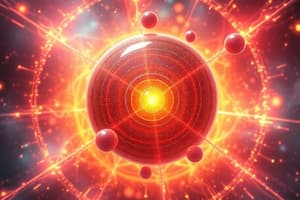Podcast
Questions and Answers
What does the atomic number of an ion indicate?
What does the atomic number of an ion indicate?
- The total number of particles in the atom
- The overall charge of the ion
- The number of protons in the ion (correct)
- The number of neutrons in the ion
How do you determine the number of electrons in a positive ion (cation)?
How do you determine the number of electrons in a positive ion (cation)?
- Add the charge to the atomic number
- Subtract the charge from the atomic number (correct)
- Add the atomic number to the charge
- Subtract the atomic number from the charge
In the ion 24Mg2+, how many neutrons are present?
In the ion 24Mg2+, how many neutrons are present?
- 12 (correct)
- 14
- 10
- 24
What calculation is used to find the number of neutrons in an atom?
What calculation is used to find the number of neutrons in an atom?
If an ion has an atomic number of 16 and a mass number of 32, what is the total number of electrons in the ion if it has a -2 charge?
If an ion has an atomic number of 16 and a mass number of 32, what is the total number of electrons in the ion if it has a -2 charge?
What particles are located in the nucleus of an atom?
What particles are located in the nucleus of an atom?
What is the charge of a proton?
What is the charge of a proton?
In a neutral atom, how are the number of electrons related to the number of protons?
In a neutral atom, how are the number of electrons related to the number of protons?
How is the mass number of an atom defined?
How is the mass number of an atom defined?
What is the mass of an electron relative to a proton?
What is the mass of an electron relative to a proton?
Which of the following statements about atomic composition is correct?
Which of the following statements about atomic composition is correct?
What is the relationship between mass number and atomic number for an atom represented as 7Li?
What is the relationship between mass number and atomic number for an atom represented as 7Li?
Where do electrons predominantly exist in an atom?
Where do electrons predominantly exist in an atom?
Flashcards
What is an atom's nucleus?
What is an atom's nucleus?
The tiny, dense center of an atom containing protons and neutrons.
What are protons?
What are protons?
Positively charged particles found in the atom's nucleus.
What are neutrons?
What are neutrons?
Neutral particles found in the atom's nucleus.
What are electrons?
What are electrons?
Signup and view all the flashcards
What is an atom's mass number?
What is an atom's mass number?
Signup and view all the flashcards
What is an atom's atomic number?
What is an atom's atomic number?
Signup and view all the flashcards
What is a nuclear symbol?
What is a nuclear symbol?
Signup and view all the flashcards
How many electrons are in a neutral atom?
How many electrons are in a neutral atom?
Signup and view all the flashcards
What are ions?
What are ions?
Signup and view all the flashcards
What are anions?
What are anions?
Signup and view all the flashcards
What are cations?
What are cations?
Signup and view all the flashcards
What is the atomic number?
What is the atomic number?
Signup and view all the flashcards
What is the mass number?
What is the mass number?
Signup and view all the flashcards
Study Notes
Atomic Structure
- Atoms are composed of protons, neutrons, and electrons.
- Protons and neutrons are found in the nucleus, which is very small and dense, containing most of the atom's mass.
- Electrons orbit the nucleus in shells/orbitals, occupying a large region of space, meaning most of an atom's volume is empty space.
- Protons have a positive charge, neutrons are neutral, and electrons have a negative charge.
- Relative masses and charges are: Proton (1,+1), Neutron (1,0), Electron (0.0005,-1).
Representing Atomic Composition
- Nuclear symbols use mass number (A) and atomic number (Z).
- Mass number (A) is the total number of nucleons (protons + neutrons).
- Atomic number (Z) is the number of protons, uniquely identifying an element.
Determining Subatomic Particles in Neutral Atoms
- Number of protons = Atomic number (Z)
- Number of electrons = Number of protons (in neutral atoms)
- Number of neutrons = Mass number (A) - Atomic number (Z)
Example: 7Li Atom
- Atomic number (Z) = 3, so 3 protons.
- Number of electrons = 3 (neutral atom)
- Mass number (A) = 7, so 7 - 3 = 4 neutrons.
Ions and Subatomic Particles
- Ions are atoms with unequal numbers of protons and electrons.
- Anions (negative ions) have more electrons than protons.
- Cations (positive ions) have fewer electrons than protons.
- To find electrons in an ion:
- For cations (positive): Electrons = Atomic number - ion charge.
- For anions (negative): Electrons = Atomic number + ion charge
Example: 7Li+ Ion
- Atomic number (Z) = 3, so 3 protons.
- Ion charge is +1, so electrons = 3 - 1 = 2 electrons.
- Mass number (A) = 7, so 7 - 3 = 4 neutrons.
Studying That Suits You
Use AI to generate personalized quizzes and flashcards to suit your learning preferences.




